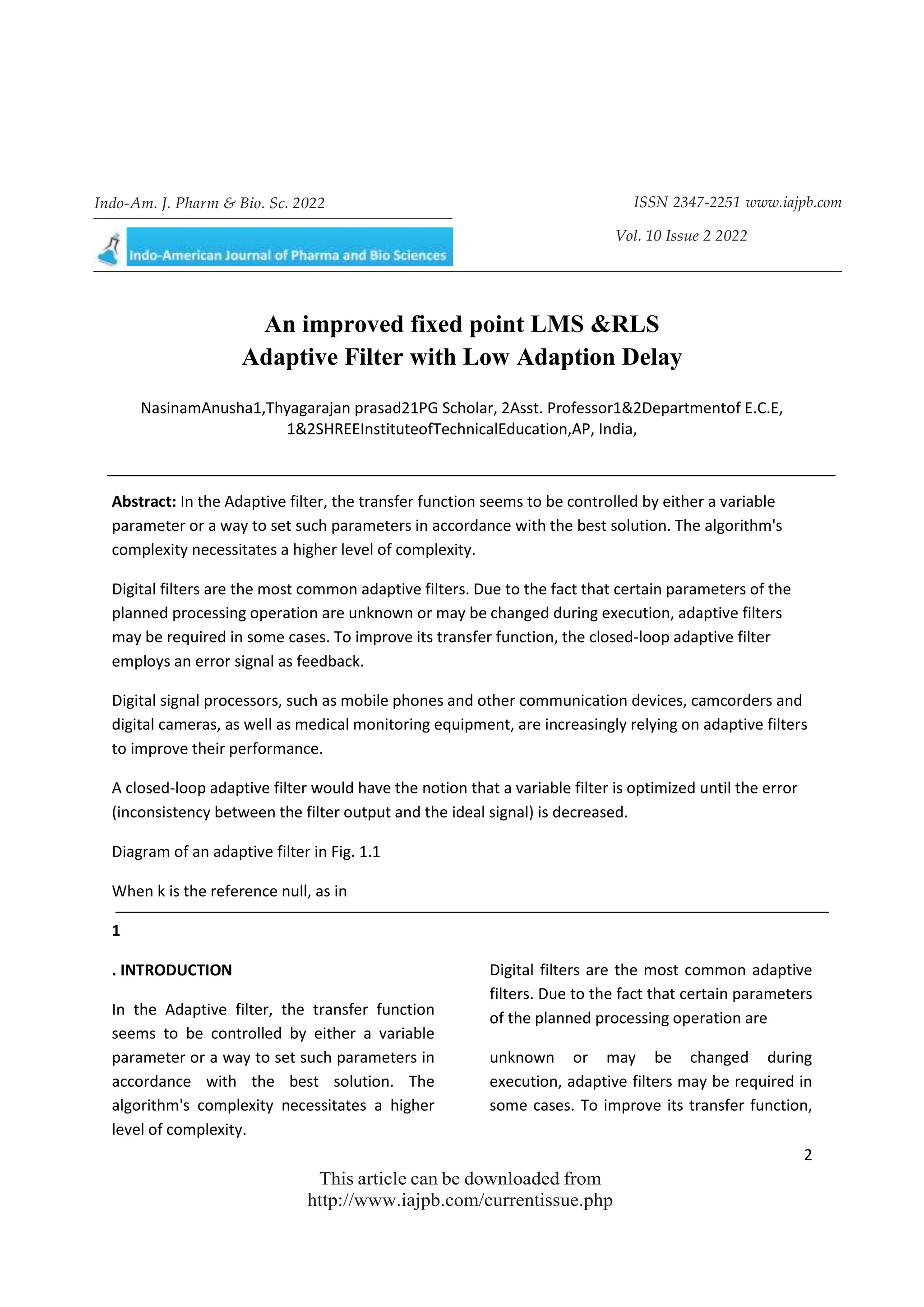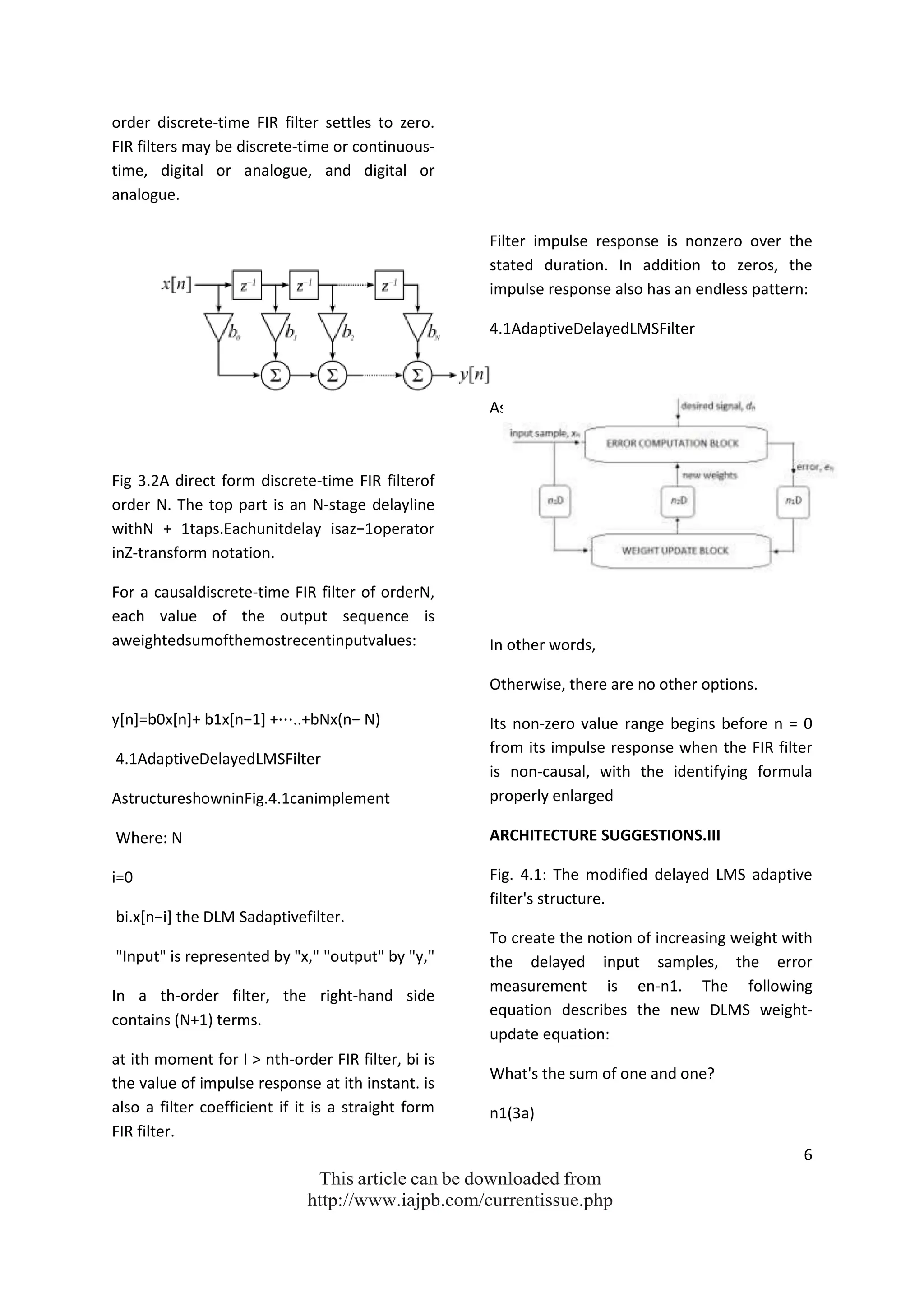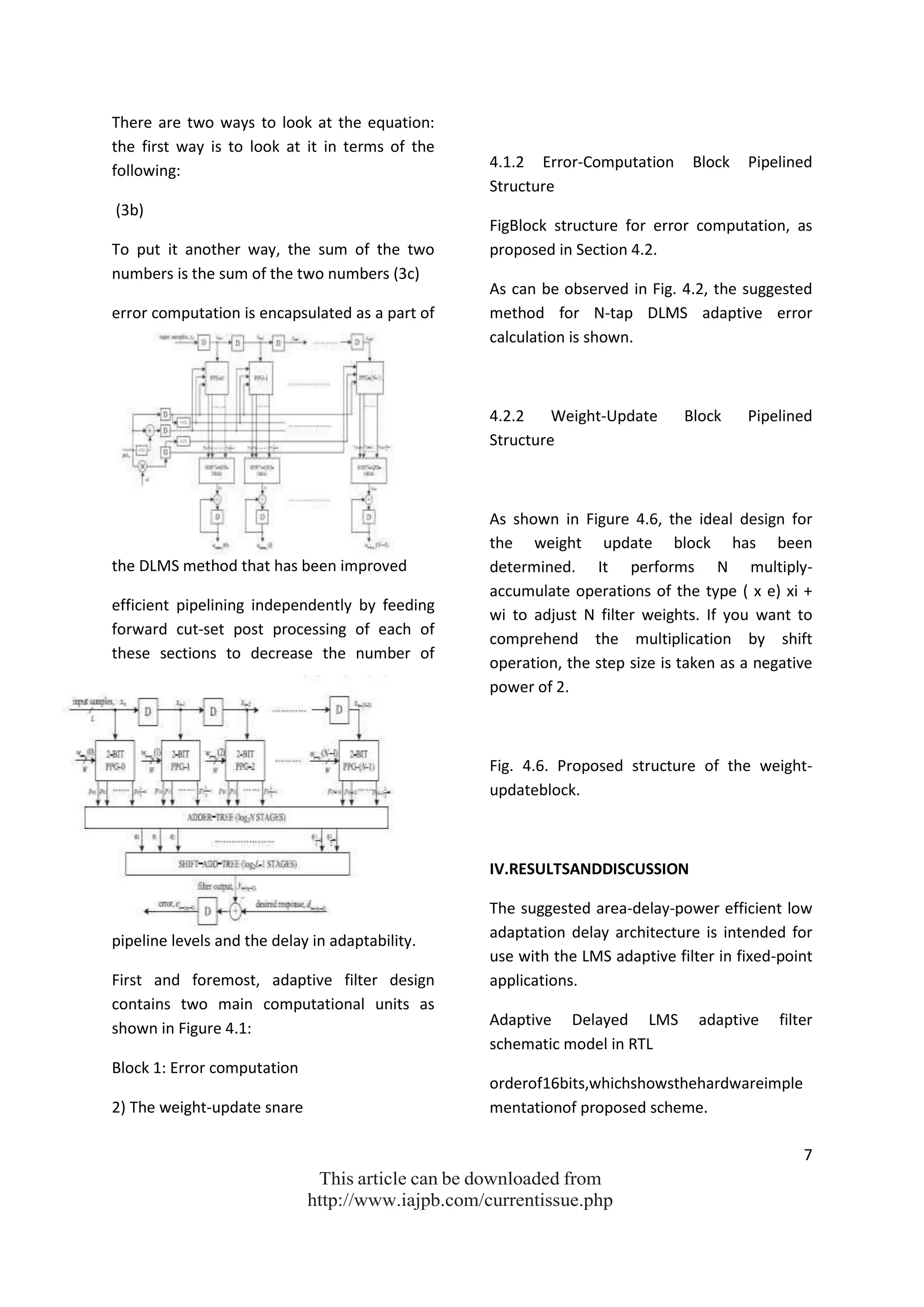This document discusses adaptive filtering techniques, specifically the Least Mean Square (LMS) and Recursive Least Squares (RLS) algorithms. It describes the basic structure and operation of adaptive filters, including their use of error signals as feedback to optimize transfer functions. The LMS algorithm is commonly used due to its computational simplicity, while RLS provides faster convergence but with higher complexity. The document proposes a modified Delayed LMS (DLMS) adaptive filter architecture to reduce adaptation delay by feeding error computations forward through pipeline stages. Simulation results show this DLMS design achieves lower area, delay and power compared to conventional LMS and RLS filters.



![4
This article can be downloaded from
http://www.iajpb.com/currentissue.php
to find the best wiener solution. It is often
utilized because of its ease of calculation.
Because of its adaptability, it has become the
standard by which all other adaptive filtering
algorithms are measured. The LMS filter is
based on the idea of updating the filter
weights to get the optimal filter weight.
Weight gain is good if the gradient is
negative. Then, as a last point,
The mean-square error is represented by (n).
A unit of measurement is a "step."
wn is the vector of weight. To summarize the
LMS algorithm for the aPth order algorithm,
P stands for the filter order in the
equation.
= size of a step Initiation: h(0) = 0. (p)
Calculation: For n=0,1,2,.....
X (n) = *x(n), x(n − 1) … … x(n − p+ 1)+
I'm not sure what I'm going to do with
this, but I'm thinking about it (n)
h (n + 1) = h(n) + µe ∗ (n)x(n)
In this section, we'll discuss the
adaptive RLS filter.
The Least Squares recursive algorithms are
the second type of adaptive filtering
techniques covered in this development
procedure (RLS). Iteratively identifies the
variables that are most relevant to the task at
hand
It seems that recursive least squares
is the best method for minimizing the cost of
optimized linear least squares for the input
signals (RLS). Gauss discovered RLS in 1821,
yet it wasn't ignored or abandoned until
Plackett reworked Gauss's original work in
1950. Adaptive filters can typically be utilized
to fix any issue, and the RLS was no exception.
Let's say a noisy and echo-y broadcast of a
d(n) signal results in a qx(n) = (bn[k]-d[n-k]+v]
interpretation of the signal (n)
k=0
Additive noise is represented by v(n). A p+1
tap FIR filter will be used to try to recover the
intended signal d(n).
EXISTINGSYSTEM. II
DLMS Adaptive Filter Adaptation Delay in
Comparison to Conventional LMS Adaptive
Filter Figure 3.1
The following is the method that
utilizes the steepest distance. The LMS
adaptive filter is widely used across the globe
because of its easy measurement and
adaptability. The durability and low
computing cost of this approach, which is a
subset of the stochastic gradient algorithm,
make it popular across the globe..
wn+1=wn+μ.en.xn(1a)
Where
d(n)=∑pwn(k)x(n−
en=dn
−ynyn](https://image.slidesharecdn.com/ijlbps62a2149ad94fb-231121071807-bb7f098b/75/journal-paper-publication-4-2048.jpg)
![5
This article can be downloaded from
http://www.iajpb.com/currentissue.php
=wTxn
(1b)
k)=wntxn
Where X(n) =*x(n), x(n − 1) … … x(n −p
+ 1)]Tvector that contains the samples from
the last p+1 iterations of x (n). Filter
parameters, as well as new least squares
predictions, are our primary goals in this
project. To discover the most recent Wn+1
computation in terms of Wn, we don't want
to reinvent the least-squares method.
Where the input vector xn, and the
weightvector wnat the nth iteration are,
respectively,given by
xn=* xn,xn−1, ,xn−N
+1]T
wn=[ wn(0),wn(1), ,wn(N
−1)]T
Filtering results in yn, the intended
answer, and an error in the nth iteration. The
step-size and the number of weights used in
the LMS adaptive filter are and N,
respectively. The en error is accessible in
pipeline topologies with m pipeline stages,
where m is the adaption delay.
As a result, the DLMS approach
demands that the en-m postponed error, i.e.
the error pertaining to (n-m)Thiteration,
modify the present weight instead of the most
relevant error. The equation for the DLMS
adaptive filter weight update is given by
wn+ 1=wn+μ•en − m•xn− m.(2)
Fig3.1:Structure of the
conventionaldelayedLMSadaptive filter.
3.1 FIRfilterblock:
A finite impulse response (FIR) filter is afilter
in signal processing of which
impulseresponse(orresponsetoanyinputoffinit
e
length) is similarly limited since it ends with
zero at the conclusion of the time period.
Filters with infinite impulse response (IIR), on
the other hand, might have individual
reactions and so attempt to remark forever
on the data they receive (usually decaying).
After exactly N + 1 samples (from the very
first nonzero element to the very last nonzero
element), the impulse response of a Nth-](https://image.slidesharecdn.com/ijlbps62a2149ad94fb-231121071807-bb7f098b/75/journal-paper-publication-5-2048.jpg)


![8
This article can be downloaded from
http://www.iajpb.com/currentissue.php
The
TechnologyschematicmodelofanAdaptiveDela
yed LMSadaptivefilter
SimulationResults:
EvaluationTableforArea,Dela
yandPower:
Area Delay power
Used
slices
Used
LUT’s
DL
MS
604
slices
1118 186.71
2ns
0.034W
DRL
S
539
slices
995 186.70
4ns
0.034W
CONCLUSSION
The suggested area-delay-power efficient low
adaptation delay architecture is intended for
use with the LMS adaptive filter in fixed-point
applications. We used an innovative PPG for
the effective implementation of certain
multiplications and inner product
computations through common sub-
expression distribution. As a result, in order to
get things done quicker,
An effective addition strategy for inner-
product calculation was presented to
significantly minimize the adaption latency in
order to handle high input sampling rates.
REFERENCES
[1] P. K. Meher and S. Y. Park, Low
adaptation-delay LMS adaptive filter part-I:
Introducing a novel multiplication cell, in Proc.
IEEE Int. Midwest Symp. Circuits Syst., Aug.
2011, pp. 1–4.
[2] P. K. Meher and S. Y. Park, Low adaptation-
delay LMS adaptive filter part-II: An optimized
architecture, in Proc. IEEE Int. Midwest
Symp.Circuits Syst., Aug. 2011, pp. 1–4.
The modified delayed LMS method is used in a
high-speed FIR adaptive filter design by P. K.](https://image.slidesharecdn.com/ijlbps62a2149ad94fb-231121071807-bb7f098b/75/journal-paper-publication-8-2048.jpg)
![9
This article can be downloaded from
http://www.iajpb.com/currentissue.php
Meher and M. Maheshwari, in Proceedings of
the 2011 International Symposium on Circuits
and Systems, pp. 121–124.
IEEE Trans. Very Large Scale Integr. (VLSI) Syst.
Vol. 13, No 1, pages 86–99, Jan. 2005, Virtex
FPGA implementation of a pipelined adaptive
LMS predictor for electronic support
measures receivers.
Yi, R. Woods, L-K. Ting, and CF Woods [5]
N. Cowan, High speed FPGA-based
microprocessor
delayed-LMS filter implementations, J. Very
Large Scale Integr. (VLSI) Signal Process., vol.
39, nos. 1–2, pp. 113–131,
The month of January, 2005.
As cited in [6]: [7] [8] [9] [10]
P. Scalart, Accuracy evaluation of fixed- point
LMS algorithm, in Proc. IEEE Int. Conf. Acoust.,
Speech, Signal Process., May 2004, pp. 237–
240.
[7] S. Haykin and B. Widrow, Least-Mean-
Square Adaptive Filters. Hoboken,NJ, USA:
Wiley, 2003.
[8] L. D. Van and W. S. Feng, An efficient
systolic architecture for the DLMS adaptive
filter and its applications, IEEE Trans. Circuits
Syst. II, Analog Digital Signal Process., vol. 48,
no. 4, pp. 359–366, Apr. 2001.
[9] K. K. Parhi, VLSI Digital Signal Procesing
Systems: Design and Implementation. New
York, USA: Wiley, 1999.
[10] S. Ramanathan and V. Visvanathan, A
systolic architecture for LMS adaptive filtering
with minimal adaptation delay, in Proc. Int.
Conf. Very Large Scale Integr. (VLSI) Design,
Jan. 1996, pp. 286–289.](https://image.slidesharecdn.com/ijlbps62a2149ad94fb-231121071807-bb7f098b/75/journal-paper-publication-9-2048.jpg)